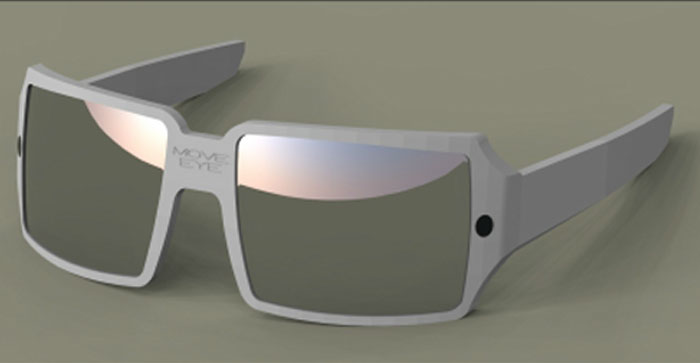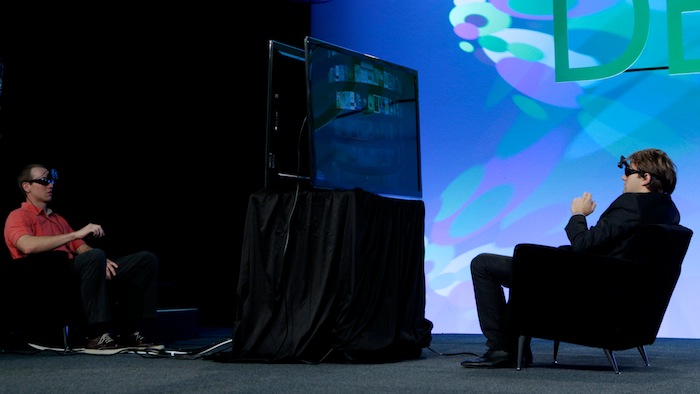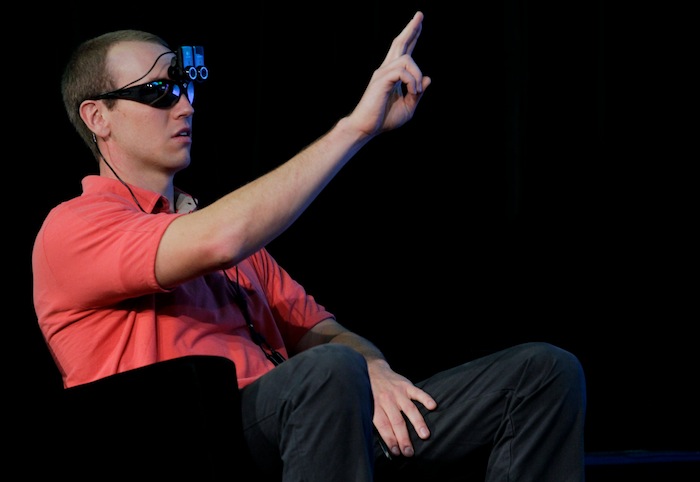
Smart TVs have the dumbest input devices, don’t they? From sliding through a carousel of apps to searching letter by painstaking letter for your favorite shows, it sometimes seems like the whole process was designed to induce mass outrage among early adopters.
Face it: TV remotes weren’t made for modern TV usage, and keyboards and mice weren’t made for TVs, either. What’s the alternative?
Check this out:

That up there is called MoveEye. It’s a smart piece of eyewear that works with software to let you control computers with gestures. It’s from Tarsier, a startup presenting today at DEMO, and it’s intended to make pain-in-the-butt interfaces like Smart TV screens a lot easier for us consumers.
“Computers aren’t as easy to communicate with as they should be,” explained Tarsier co-founder Shafa Wala in a recent email exchange with VentureBeat.
“For each person accessing the quality learning and information sources computers provide, six remain in the dark. We think the world is a better place when people are informed and using computers. … MoveEye has the ability to bring computing to the masses in a way no other technology has since the mouse.”
MoveEye is specifically designed to let humans interact with computer screens (including TV screens) from any viewable angle and distance.
The MoveEye product includes the Google Glass-reminiscent glasses seen above, as well as software that maps out the areas of the screen you’re controlling. The software also includes a gesture library. Unlike Kinect, MoveEye devices see what the user sees and are able to operate from the user’s perspective rather than solely from the device’s perspective.
Here’s a pic of the team showing off an early prototype device today onstage:

Microsoft’s Kinect controller is a step in the right direction when it comes to UI and navigation. In fact, the popular gaming device is now being brought into broader use cases such as education and retail thanks to Kinect for Windows. But the Tarsier team thinks Kinect doesn’t go far enough.
MoveEye’s creators also see it as a great tool for experiencing immersive 3D, interacting with the interface using depth cues. Can you imagine how useful that might be for, say, surgeons?
“With new computer designs like the Raspberry Pi, the barrier to entry is no longer the cost of the computer itself; it’s the skills to be able to use it,” Wala continued.
“We think the technology we have created has the foundation to be one of the most intuitive ways to communicate with computers the world has seen.”
Tarsier, founded in St. Paul, Minn., in 2010, has currently taken a small $55,000 round from local investors and is seeking more funding. Next up, the startup team hopes to grow its employee headcount.
“Once we have the right personnel, our engineering team will be working to transition the prototype to a consumer-ready device while our business team seeks out potential licensees and strategic partners,” said Wala.
Tarsier is one of 75 companies and 6 student “alpha” startups chosen by VentureBeat to launch at the DEMO Fall 2012 event taking place this week in Silicon Valley. After we make our selections, the chosen companies pay a fee to present. Our coverage of them remains objective.
Photo credit: Stephen Brashear. Top image courtesy of Kiselev Andrey Valerevich, Shutterstock
VentureBeat's mission is to be a digital town square for technical decision-makers to gain knowledge about transformative enterprise technology and transact. Learn More

